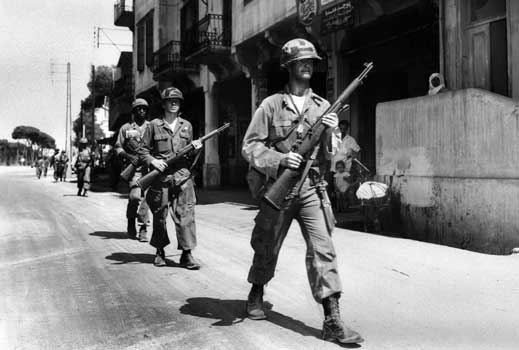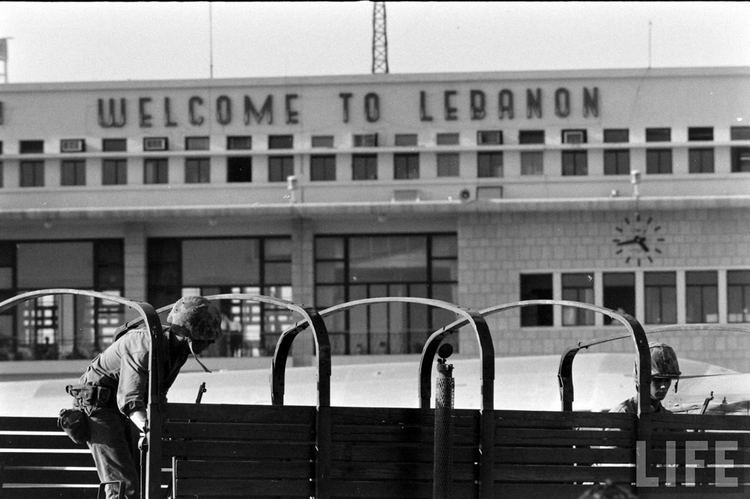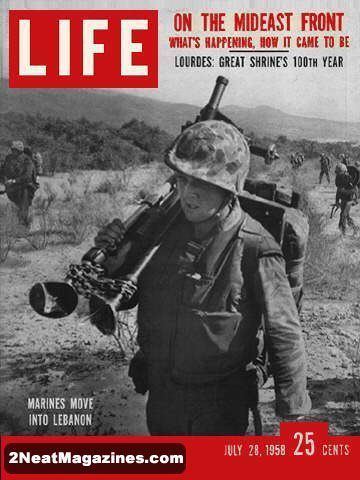Dates 15 Jul 1958 – 25 Oct 1958 | ||
 | ||
Results American-led government victory Combatants Lebanon, United States of America, United Arab Republic, Lebanese Communist Party Similar Lebanese Civil War, Franco‑Syrian War, 2008 conflict in Lebanon, 2007 Lebanon conflict, South Yemen insurgency | ||
1958 lebanon crisis interview
The 1958 Lebanon crisis was a Lebanese political crisis caused by political and religious tensions in the country that included a U.S. military intervention. The intervention lasted around three months until President Camille Chamoun, who had requested the assistance, completed his term as president of Lebanon. American and Lebanese government forces successfully occupied the port and international airport of Beirut. With the crisis over, the United States withdrew.
Contents
- 1958 lebanon crisis interview
- Seouldrift7 1958 lebanon crisis tribute
- Background
- Operation Blue Bat
- References

Seouldrift7 1958 lebanon crisis tribute
Background

In July 1958, Lebanon was threatened by a civil war between Maronite Christians and Muslims. Tensions with Egypt had escalated earlier in 1956 when pro-western Christian President Camille Chamoun did not break diplomatic relations with the Western powers that attacked Egypt during the Suez Crisis, angering Egyptian President Gamal Abdel Nasser. These tensions were further increased when Chamoun showed closeness to the Baghdad Pact. Nasser felt that the pro-western Baghdad Pact posed a threat to Arab nationalism. As a response, Egypt and Syria united into the United Arab Republic (UAR). Lebanese Sunni Prime Minister Rashid Karami supported Nasser in 1956 and 1958. Karami formed a national reconciliation government after the 1958 crisis ended.

Lebanese Muslims pushed the government to join the newly created United Arab Republic, while the Christians wanted to keep Lebanon aligned with Western powers. A Muslim rebellion that was allegedly supplied with arms by the UAR through Syria caused President Chamoun to complain to the United Nations Security Council. The United Nations sent a group of inspectors that reported that it didn't find any evidence of significant intervention from the UAR.

The toppling of a pro-Western government in Iraq's 14 July Revolution, along with the internal instability, caused President Chamoun to call for American assistance.
Operation Blue Bat

U.S. President Eisenhower responded by authorizing Operation Blue Bat on July 15, 1958. This was the first application of the Eisenhower Doctrine under which the U.S. announced that it would intervene to protect regimes it considered threatened by international communism. The goal of the operation was to bolster the pro-Western Lebanese government of President Camille Chamoun against internal opposition and threats from Syria and Egypt. The plan was to occupy and secure the Beirut International Airport, a few miles south of the city, then to secure the port of Beirut and approaches to the city.

The chain of command for Operation Blue Bat was as follows: the Eisenhower administration at the strategic level; Specified Command, Middle East (SPECCOMME, a 'double-hat' for Commander in Chief, U.S. Naval Forces, Eastern Atlantic and Mediterranean) at the operational level; the Sixth Fleet, with aircraft carriers USS Saratoga, USS Essex, and USS Wasp, cruisers USS Des Moines and USS Boston, and two squadrons of destroyers. At the end of June Essex and Boston were anchored at Piraeus, Greece, while Des Moines, from which Vice Admiral Charles R. Brown was flying his flag, was at Villefranche-sur-Mer. Land forces included the 2nd Provisional Marine Force (Task Force 62) and the Army Task Force 201 at the tactical level. Each of these three components influenced Operations Plan 215-58 and its execution.
The operation involved approximately 14,000 men, including 8,509 United States Army personnel, a contingent from the 1st Airborne Battle Group, 187th Infantry from the 24th Infantry Division (based in West Germany) and 5,670 officers and men of the United States Marine Corps (the 2nd Provisional Marine Force, of Battalion Landing Teams 1/8 and 2/2).The 2nd Battalion 8th Marines arrived on July 16 after a 54-hour airlift from Cherry Point, North Carolina They were supported by a fleet of 70 ships and 40,000 sailors. On July 16, 1958, Admiral James L. Holloway, Jr., CINCNELM and CINCSPECCOMME, flew in from London to Beirut airport and boarded USS Taconic, from which he commanded the remainder of the operation. The U.S. withdrew its forces on October 25, 1958.
President Eisenhower sent diplomat Robert D. Murphy to Lebanon as his personal representative. Murphy played a significant role in convincing both sides of the conflict to reach a compromise by electing moderate Christian general Fuad Chehab as incoming President, while allowing Chamoun to continue in power until the end of his term on September 22.
